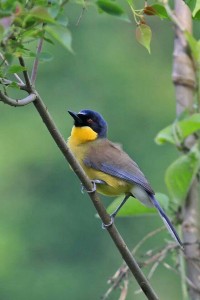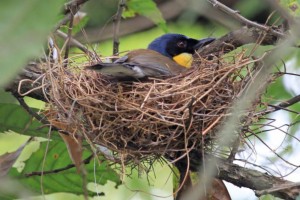Week 60 – 03 September 2017:
Is it Possible to be Too Popular?
I have never seen a Blue-crowned Laughingthrush, and there is a high probability that I never will.
According to the International Union for the Conservation of Nature (http://www.iucnredlist.org/details/22732350/0), this beautiful laughingthrush is critically-endangered. Its current population is unlikely to exceed 240 mature birds, all of which are found within an extremely restricted breeding range in China’s Jiangxi Province. It seems that, in the past, the trapping of individuals for the pet trade was the major cause of the bird’s decline, with 400 birds known to have been taken between 1987 and 1992. A subsequent international ban on the trade of Blue-crowned Laughingthrushes greatly diminished their value, and so the rate of capture declined. Even so, the species continues to be threatened by urban development and road construction.
A recent report by Weiwei Zhang and colleagues at the Jiangxi Agricultural University and the Northeast Forestry University described aspects of the Blue-crowned Laughingthrush’s natural history, and identified a new threat to its survival.
This laughingthrush has the misfortune to be both beautiful and rare. It is, therefore, popular with bird enthusiasts willing to travel. These birds breed only in broadleaf trees in and around a limited number of villages in the region of Jiangxi Province known as Wuyuan. The spot is considered to be among the most beautiful landscapes in China, and home to a rich diversity of birds. Among the nine breeding sites known to Weiwei Zhang and colleagues, the largest laughingthrush population is also the most popular with birdwatchers and photographers. Between 2012 and 2016, the research team found 82 nests at this site, Shimen. Other sites, such as Hexi and Zhongyun, had only one or two nests, and were not occupied in every year.
Weiwei Zhang and crew used a clever approach to determine differences in potential disturbance of nesting Blue-crowned Laughingthrushes by photographers; they counted the number of photographs of the bird posted online. The focused on the website Birdnet, which they described as “the main web site for bird photo sharing in China.”
The team discovered that most of the Blue-crowned Laughingthrush photographs had been taken in Shimen. Not only was that laughingthrush population the largest and best know, but it also provided room-and-board opportunities for visitors in search of the birds. The birds in Shimen built their nests higher in trees than they did at other sites, and shorter tree species that were used at other sites were avoided at Shimen. The birds also nested further from village buildings at the most disturbed site. The researchers concluded that “the disturbance from birding visitors may exacerbate the endangered status of this bird.”
There is no doubt that ecotourism can be a powerful tool in the struggle to conserve wildlife and wild spaces. A lot of people are willing to pay a lot of money for the opportunity to see new and exotic creatures. A tree, standing up, home to a beautiful bird, may be a lot more valuable to the local community than the same tree that has been cut down for lumber. Even so, it is abundantly clear that ecotourism cannot be allowed to endanger the wildlife that it is is featuring. Even though the Blue-crowned Laughingthrush is considered to be critically-endangered by the IUCN, it is not classified as a protected species in China. Consequently it not legally protected against excessive disturbance from birdwatchers and photographers.
I have never seen a Blue-crowned Laughingthrush, and for the sake of the bird, I probably won’t try to do so.
Weiwei Zhang, Jinze Shi, Huiqin Huang and Tao Liu. 2017. The impact of disturbance from photographers on the Blue-crowned Laughingthrush (Garrulax courtoisi). Avian Conservation and Ecology 12(1):15.
Photo credits: Blue-crowned Laughingthrush – www.pinterest.com; incubating adult, photograph taken by Phillip Edwards – www.hbw.com



